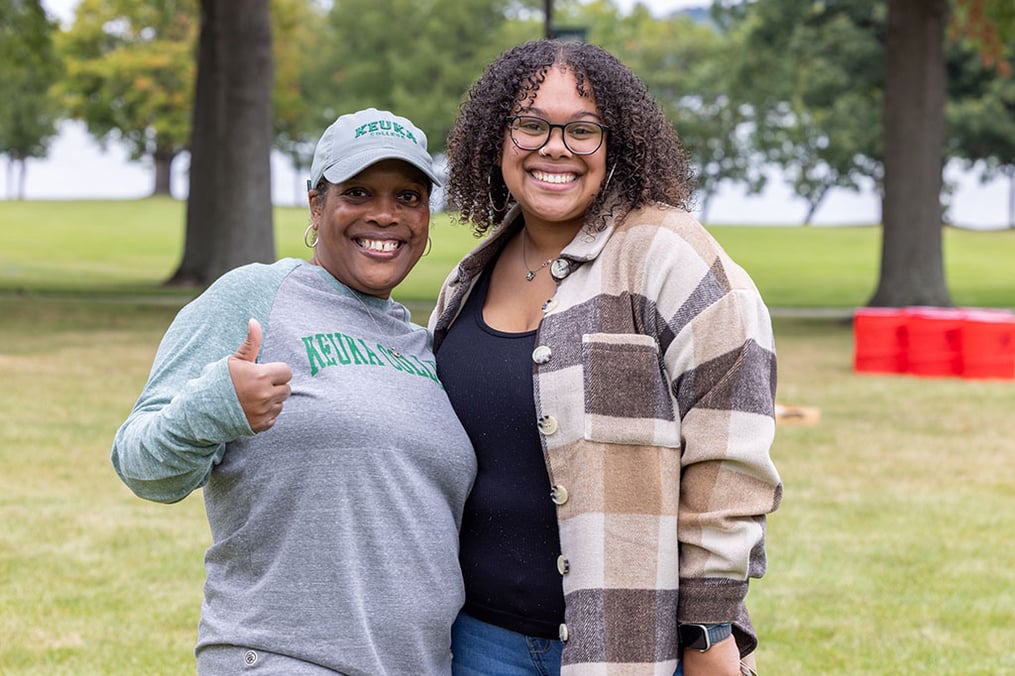"Free tuition" doesn’t come without costs. Take a look at the requirements associated with New York State’s promised Excelsior Scholarship, then compare them with the guarantees associated with an education at Keuka College.
| Criteria | Excelsior Scholarship | Keuka College |
|---|---|---|
| Availability | The Excelsior Scholarship may not be universally available. Students must be state residents and their annual family incomes may not exceed $100,000. In addition, the state Legislature has set aside just $87 million – a figure that would likely fall far short in accommodating the roughly 900,000 students who would be eligible to apply. A lottery system is one of the options being considered to determine which students will receive the aid. | At Keuka College, financial assistance doesn’t come about by the luck of the draw. The College distributed $14.8 million to students last year alone. About 98% of our students receive scholarships and/or grant money each year. |
| What It Covers | The Excelsior Scholarship covers only tuition. It may not be applied to any other college-related expenses, including room and board, supplies, student fees, or other financial responsibilities. In addition, Excelsior Scholarship dollars are applied only after other forms of financial support, like federal Pell Grants and New York State’s Tuition Assistance Program (TAP), have been utilized. Because of this, it isn’t likely to have much effect on the lowest-income students, many of whom already receive enough financial assistance to cover public-college tuition. | At Keuka College, financial assistance can be utilized across the board based on area of need. TAP is used specifically to pay for tuition. However, all other financial aid can be utilized for tuition, fees, room, board and other educational expenses. |
| In-School Requirements | The Excelsior Scholarship requires students to carry at least 12 credit hours every semester (although they must complete 30 credit hours every academic year; an average of 15 per semester). They also must successfully pass all courses. | At Keuka College, financial assistance is available to all students as long as they maintain eligibility and the academic minimum set by the College. |
| Post-Graduation Requirements | The Excelsior Scholarship requires recipients, upon graduation, to live and, if employed, work in New York State for as many years as the aid was received. Failure to do so could trigger the grant converting to a loan. That could mean as many as four years in which students would be limited from seeking all but in-state opportunities. | At Keuka College, students are not financially discouraged from working or living wherever they please upon graduation. In addition, Keuka College will never convert promised scholarships into loans after the fact. |
Additional Facts & Information
- Keuka College’s three-year loan default rate is a low 5.6%, far below the national average of 11.3%, an indicator of our graduates’ success in the job market. Further evidence was reflected in a recent New York Times story that ranked the College in the top 10% nationwide in the economic mobility of its graduates.
- The Excelsior Scholarship covers four years of college. Students who require more than four years to graduate – and that is the majority of public college students in New York – would see future assistance revert to loans. The four-year graduation rate for public colleges in New York is just 38.7% (2013 figures, according to the Chronicle of Higher Education). In addition, students who are already in college must be on track to graduate in four years to qualify for scholarship consideration.
- Transferring to a SUNY college is not seamless. It is not guaranteed that all earned credits will be accepted by SUNY, potentially imperiling eligibility for Excelsior Scholarships.
- Regarding the state’s post-graduation residency requirement: Does the state – especially upstate – have the jobs to accommodate this potential influx of new job-seekers? And should newly minted graduates be penalized if not?
- Rather than further subsidizing public colleges, the Council of Independent Colleges estimates that, were New York State officials to incentivize private school students with additional $1,000 grants, at least 6,500 students would transfer from public to private colleges. The CIC estimates in a newly released report that the state would thus save some $159 million in public college spending.
Additional Resources
Why Gov. Cuomo’s Free Tuition Plan Hurts Private Colleges (Real Clear Education; May 17, 2017): “Private institutions … typically offer smaller class sizes, better faculty-student ratios and more personalized attention both in the classroom and in student support across campus. These are resources necessary to help students overcome obstacles that might cause them to drop out.”
Not Exactly Free (Inside Higher Ed; May 16, 2017): “The credit accumulation requirement will be devastating to the neediest students.”
Why Gov. Cuomo’s ‘Free College’ Plan Will Fail Miserably (The Federalist; May 16, 2017): “The Excelsior Scholarship may be the most badly conceived education reform of the decade.”
Private Colleges Can Partner to Solve Issues (Edwardsville Intelligencer; May 8, 2017): “(W)hen developing state and federal policies for state and federally funded institutions, the role of private colleges and universities should not be ignored.”
As College Deadlines Near, Families Wonder What They Can Pay (New York Times; April 28, 2017): “(F)ree tuition does not solve every family’s financial challenge. Qualifying families in New York may still need to cover more than $50,000 over four years for fees, room and board.”
N.Y.’s Free-Tuition Plan Sows Confusion About What Private Colleges Can Offer (Chronicle of Higher Education; April 24, 2017): “Some students have asked whether the free tuition means that classes will be more crowded at the state’s colleges. No one knows for sure.”
Report: States Could Save Funds By Assisting Students With Private College Tuition (Education Dive; April 17, 2017): “Some private college presidents worry that the announcement could lead to a conflict between public and private universities in the midst of an immediate future where federal and state education funding cuts for public universities are all but assured.”
The Cuomo College Fiasco (New York Times; April 14, 2017): “(P)rivate colleges tend to have smaller classes, they tend to do a better job of graduating their students and they tend to spend heavily to subsidize poorer students.”
Incentives to Attend Private Colleges Could Save States Money and Raise Graduation Rates (Chronicle of Higher Education; April 14, 2017): “If New York had chosen to provide $1,000 incentives to students who picked private colleges instead of committing to a free-tuition program that will eventually cost $163 million a year, ‘it’s pretty clear to us that the state could have saved money, more people could go to college, and you wouldn’t be devastating the private sector,’ said Mr. Ekman.”
What New Yorkers Don’t Like About the New Free Tuition Scholarship (CNN Money; April 14, 2017): “There's a big consequence for moving or working out of state.”
Free College Plan Isn’t All It’s Cracked Up to Be (Fortune; April 13, 2017): “(T)here are some important flaws in its design that will cap its benefits for many and even make some worse off.”












